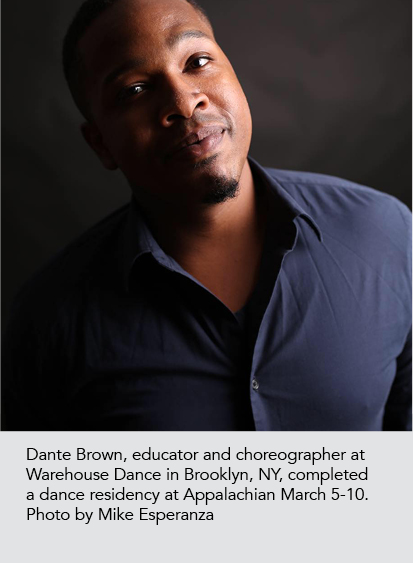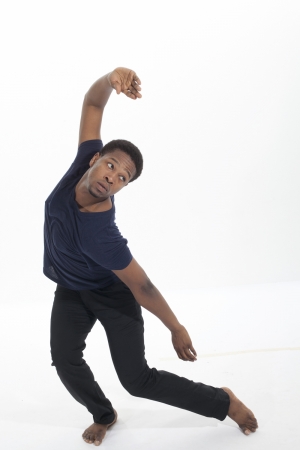By Nancye Edwards
Dante Brown, choreographer and educator at Warehouse Dance in Brooklyn, New York, joined faculty and students in Appalachian State University’s Department of Theatre and Dance as a guest artist for a weeklong dance residency March 5–10. Along with teaching modern dance and hip-hop classes and discussing his work in dance history and choreography courses, Brown choreographed a piece specifically for Appalachian students. The work will premiere as part of the department’s Spring Appalachian Dance Ensemble concert March 29–April 1.

Brown, who studied dance at Wesleyan University and later received a Master of Fine Arts in Dance/Choreography at The Ohio State University, formed Warehouse Dance Studio in 2010. He seeks to foster a collaborative environment where artists question conventional dance styles, evolving a movement space dedicated to the development of artists through “physical and theoretical inquiry.”
While on campus, Brown discussed his approach as a choreographer and his experience working with Appalachian students.
What is your approach to choreography?
Brown: I approach choreography from a collaborative standpoint. I believe everyone can dance and it’s up to the choreographer to frame it on stage and highlight the aspects and attributes of that movement. I work with very, very different dancers and I start off with certain prompts and improvisational scores so I can find what inspires them to move, and then I start making choreography in response.
How did you develop that process?
Brown: The companies I danced with inspired my mentality. I worked a lot with a couple of dance companies, David Dorfman Dance in New York, and (Liz Lerman’s) Dance Exchange in Takoma Park, Maryland. Both companies work off of a similar model. Liz Lerman is a huge American modern dance pioneer who created the mentality that everyone can dance.
What do you enjoy most about teaching?
Brown: I love to see the transformation of students in terms of technique, but even more so see them embody a culture rather than a shape and space. Seeing the confidence in a person grow is so much more important to me than making a dance.
How was your experience working with and teaching Appalachian students?
Brown: So chill. Going to a small town in North Carolina and a larger school, as a queer, black male, I wondered where I was going to fit in; but everyone is very welcoming, very supportive, and people are really responsive to the information I’ve been giving out.

On the Warehouse Dance Studio website, it says much of your work is focused on “thematic environments.” Have you incorporated any similar themes during your residency here in Boone?
Brown: I’ve been reading Ta-Nehisi Coates’ book “Between the World and Me.” Essentially, the whole book is a letter to Coates’ son about his experience growing up in Baltimore involving race and power. Coates makes a lot of references to the American dream, so we’ve been playing with the idea of how “shame” operates as a mechanism to deter people from the mentality of the American dream. We’ve talked about ideas of identity, and which identity markers have more access to the dream than others. Yesterday we had our first really emotional day where there were tears. The piece pulls up things that are so current right now such as Black Lives Matter, Trans Lives Matter, and Women’s Rights. The piece is called “Loophole.”
What aspect of the choreography process moved the dancers to tears?
Brown: We took aggressive gestures that you normally see every day; they are very sharp in space, very poignant. We slowed them down and made them very soft, very luxurious, they had this melting quality. A young black male is a part of the ensemble and he asked me to demonstrate. By the end of the phrase, he just kind of broke. We all surrounded him and comforted him in the process, which I think that’s when everyone broke. I talk a lot about this idea of when you’re making a dance, are you making the real fake or the fake real? They are two very different things, and a lot of the work I try to make is about replicating what we experience in the day-to-day.
Have you experienced similar emotional moments when teaching other groups?
Brown: Pretty much in every residency I go to lately. It’s interesting, and I don’t know if it’s a generational thing, but a lot of the work I do is social commentary. People are very responsive to it. I honestly have no intention to make people cry, but it’s nice to know they care enough to have that connection with the work.
Given the current social and political climate, how does your company reflect and comment on the emotional atmosphere of our society?
Brown: I created a performance series in New York. It’s at the end of May and the donations will go to Black Lives Matter. There are nine choreographers who pull in all sects, because in New York there are so many sects of dance like uptown, downtown, etc. It’s pulling all those communities together for the sake of a common good, so that’s my personal attempt because I got tired of the cattiness of the dance world.
Did you ever see yourself living and working in New York? What was your career journey?
Brown: I went to Wesleyan (as an) undergrad because my brother was eight years older than me, so I saw the whole college process. Wesleyan was one school that always stuck in my mind, and I visited and fell in love with the climate. It encouraged me to travel more and get out of Virginia. It was so comfortable and so nice to the point where I decided I had to go and get out of my comfort zone. During my last year of graduate school, I had a hard choice: I either had to do this (move to New York) or (not). I decided to go for it, so I just packed my bags and moved to Brooklyn.
How do you use collaboration as a focus of your studio?
Brown: Collaboration is a touchy topic in dance right now because ownership of material is so important. I think dancers are starting to realize ‘hey, that’s mine. I want that paycheck. I want some of the royalties.’ Essentially right now I treat it as a means of trying to figure out who this dancer is. That way I can find ways of amplifying those traits and honestly making the best dancer for the work.
Do you have a favorite piece that you’ve worked on with Warehouse Dance?
Brown: My favorite piece is called “Package.” It’s around this idea of bromance, but we’re bringing it back now (with) an entirely female cast. We’re completely changing it by having them all wear presidential masks, starting with Nixon onward, and fraternity attire. We’re really challenging the idea of gender and hyper-masculinity, especially in politics.
Did you solely choreograph the piece “Package?”
Brown: “Package” is one of the few pieces choreographed strictly by me. It started off as a duet and the two dancers had about 32 counts of improve (isational) score. It was a very set ‘this is what Warehouse Dance does’ (piece) focused around the idea of claiming space and moving your kinesphere and thinking about dynamic quality as you do it, which is very derivative from hip hop. That was the first piece (in which) I just went for the athleticism in dance.
Where do you derive your inspiration?
Brown: Right around (that) time, all those Paul Rudd movies were coming out. I was like ‘what are all these ‘bromance’ movies? What is this?’ Also, it was around the time when gay marriage was really questionable. There was this really strong rub between popular culture with this brotherly love, kind of bromancey, and the friction (of) allowing gay rights to move forward. I thought it was an interesting time to make a commentary.
What style of dance is your choreography?
Brown: I would consider my style contemporary in the broadest sense because I feel like contemporary in New York is very different than contemporary in “So You Think You Can Dance,” though they’re both valid.
Any advice or wisdom for our students who aspire to be dancers or choreographers?
Brown: Keep making and keep dancing. What’s nice about this campus is (that) everyone is so kind. I’m curious to know the ways (that) the arts on this campus can have a larger presence and voice. When I first drove here, I saw that (football) stadium a half mile away; but I am interested in all schools and ways you can create inclusion for all bodies. I think the arts do a great job of that, but there are so many more ways and avenues of going about it. I’ve been working on a project titled Our Lips. I go around (to) small towns and find AA meetings, NA meetings, LGBTQ meetings. I do movement workshops and ask people if they’re interested in sharing their material. I record just their lips or any uplifting message to culminate as an online resource. It’s going to take some time. It’ll probably be a four or five year endeavor, but it’s made me realize (that) the stage isn’t the only place for performance.
See “Loophole” and seven other original dance works
The Spring Appalachian Dance Ensemble concert, featuring “Loophole” by Dante Brown, will be presented by The Department of Theatre and Dance at Appalachian State University at 7 p.m. March 29–April 1 in the Valborg Theatre on the university campus. Ticket prices are $10 for students and $17 for adults. For more information, call the Schaefer Center box office toll-free at 800-841-ARTS (2787), contact the Valborg Theater box office at 828-262-3063, or visit www.theatreanddance.appstate.edu.
About the Department of Theatre and Dance
The Department of Theatre and Dance is one of seven departments housed in Appalachian’s College of Fine and Applied Arts. Its mission is to facilitate transformative experiences for students and the public, which cultivate compassionate, creative and collaborative communities through theatre and dance. The department also offers coursework for integrated learning through the arts to the general university student population. Its dynamic co-curricular production program provides exemplary theatre and dance experiences to departmental students, the university community and the region.
About Appalachian
Appalachian State University, in North Carolina’s Blue Ridge Mountains, prepares students to lead purposeful lives as global citizens who understand and engage their responsibilities in creating a sustainable future for all. The transformational Appalachian experience promotes a spirit of inclusion that brings people together in inspiring ways to acquire and create knowledge, to grow holistically, to act with passion and determination, and embrace diversity and difference. As one of 17 campuses in the University of North Carolina system, Appalachian enrolls about 18,000 students, has a low student-to-faculty ratio and offers more than 150 undergraduate and graduate majors.

